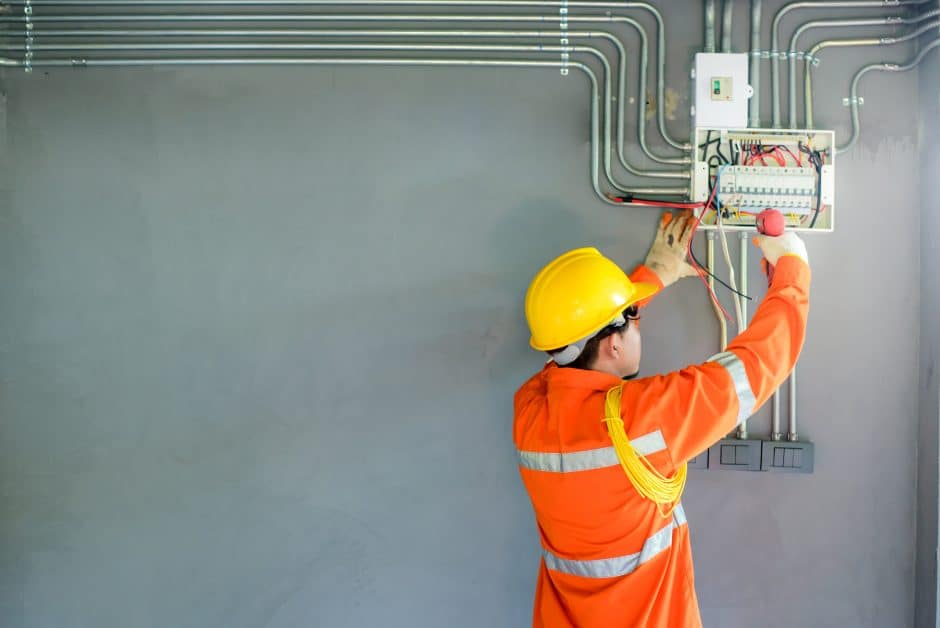
Considering a career as an electrician? This trade career requires a specialized set of skills gained through education and training, as well as a license. But with competitive salaries—median pay is above $55,000/year—and a strong job outlook in the years ahead, it’s definitely worth finding out how to become an electrician.
What does an electrician do?
Electricians install, maintain, and repair power, communications, and lighting systems in a number of settings, including residential areas and commercial buildings. They may also work directly for a power company to assist in helping areas regain their electricity after power lines are downed in a storm. Alternatively, an electrician can work as an independent contractor and help a rotating list of clients, or as a maintenance electrician for a commercial real estate property.
Electricians and electrical engineers have many responsibilities on a jobsite, and may need to know how to do any (or all) of the following:
- Read blueprints, especially MEP prints.
- Find the best routes for wiring and design systems that can be safely and continuously operated.
- Install wiring.
- Design energy-efficient lighting systems.
- Test systems like circuit breakers and identify problems.
- Make sure a homeowner or building owner can use and maintain all equipment.
- Design lighting and fire protection systems.
- Design standby power systems.
Journeyman vs. master electrician
While there are a number of specialties within an electrician career path, there are two levels based on job experience and licensing: journeyman and master electrician.
- Journeyman electrician is the title earned after completing an apprenticeship program and passing the initial licensing exam.
- Master electrician is the title earned after completing a certain number of hours (determined by your state). In some places, that might also involve taking an additional exam.
Both journeyman and master electricians typically need to complete continuing education in order to keep their license current.
Types of electricians
There are many types of electrician jobs depending on the type of environment you want to work in.
Residential electrician. As a residential electrician, you’ll primarily work in homes or apartment buildings. The job entails installing new power or lighting lines, as well as troubleshooting when problems occur, like replacing breakers or circuit boards. You can either work for an established company or strike out on your own and accumulate your own residential clients.
Commercial electrician. A commercial electrician focuses on larger buildings, which also means larger electrical systems. Job sites could include office buildings, shopping centers, or restaurants. You could install and test new control and lighting systems, or locate and fix electrical shorts and other problems.
Industrial electrician. Industrial electricians work in places like hospitals, schools, and factories. As expected, maintenance is a crucial responsibility in this job in order to keep these buildings and their equipment functioning at all times.
Inside wireman. This is a specialization that focuses on the electrical connections from an external power source to the inside of a building. This role is typically reserved for commercial facilities. In addition to installing conduits and wires, inside wiremen (or women) may be responsible for motors, alarm systems, and other types of controls.
Outside lineman. This job encompasses working on the transmission lines that connect the power facility to buildings, both residential and commercial. The outdoor work can be rigorous and involve climbing, working from heights, and dealing with inclement weather. In addition to regular maintenance, outside linemen also work to restore electricity during and after heavy storms.
Considering a career as an electrician? This trade career requires a specialized set of skills gained through education and training, as well as a license. But with competitive salaries—median pay is above $55,000/year—and a strong job outlook in the years ahead, it’s definitely worth finding out how to become an electrician.
What does an electrician do?
Electricians install, maintain, and repair power, communications, and lighting systems in a number of settings, including residential areas and commercial buildings. They may also work directly for a power company to assist in helping areas regain their electricity after power lines are downed in a storm. Alternatively, an electrician can work as an independent contractor and help a rotating list of clients, or as a maintenance electrician for a commercial real estate property.
Electricians and electrical engineers have many responsibilities on a jobsite, and may need to know how to do any (or all) of the following:
- Read blueprints, especially MEP prints.
- Find the best routes for wiring and design systems that can be safely and continuously operated.
- Install wiring.
- Design energy-efficient lighting systems.
- Test systems like circuit breakers and identify problems.
- Make sure a homeowner or building owner can use and maintain all equipment.
- Design lighting and fire protection systems.
- Design standby power systems.
Journeyman vs. master electrician
While there are a number of specialties within an electrician career path, there are two levels based on job experience and licensing: journeyman and master electrician.
- Journeyman electrician is the title earned after completing an apprenticeship program and passing the initial licensing exam.
- Master electrician is the title earned after completing a certain number of hours (determined by your state). In some places, that might also involve taking an additional exam.
Both journeyman and master electricians typically need to complete continuing education in order to keep their license current.
Types of electricians
There are many types of electrician jobs depending on the type of environment you want to work in.
Residential electrician. As a residential electrician, you’ll primarily work in homes or apartment buildings. The job entails installing new power or lighting lines, as well as troubleshooting when problems occur, like replacing breakers or circuit boards. You can either work for an established company or strike out on your own and accumulate your own residential clients.
Commercial electrician. A commercial electrician focuses on larger buildings, which also means larger electrical systems. Job sites could include office buildings, shopping centers, or restaurants. You could install and test new control and lighting systems, or locate and fix electrical shorts and other problems.
Industrial electrician. Industrial electricians work in places like hospitals, schools, and factories. As expected, maintenance is a crucial responsibility in this job in order to keep these buildings and their equipment functioning at all times.
Inside wireman. This is a specialization that focuses on the electrical connections from an external power source to the inside of a building. This role is typically reserved for commercial facilities. In addition to installing conduits and wires, inside wiremen (or women) may be responsible for motors, alarm systems, and other types of controls.
Outside lineman. This job encompasses working on the transmission lines that connect the power facility to buildings, both residential and commercial. The outdoor work can be rigorous and involve climbing, working from heights, and dealing with inclement weather. In addition to regular maintenance, outside linemen also work to restore electricity during and after heavy storms.
How to become an electrician
There are several steps you must take in order to become an electrician, but you’ll need a high school diploma or GED before you get started. Once that milestone is complete, there are three main steps to becoming licensed.
Step 1: Attend a trade school. Vocational schools and community colleges have electrician training programs, which usually last two years. This can give you a jump-start on gaining the knowledge required to succeed on the job. However, it’s important to note that most states don’t require a trade school certificate. You could skip this step and move directly onto your apprenticeship, but your educational hours would likely satisfy some of the required hours for on-the-job training.
Step 2: Enroll in an apprenticeship program. An apprenticeship is part of the journeyman licensing process. These jobs are paid and you typically need to work up to five years before you can get your license. Each state has its own requirements for how many hours you must complete as an electrician’s apprentice. In order to become an electrician in California, for instance, you must work 8,000 hours.
Step 3: Pass your state license exam. As your apprenticeship draws to a close, you’ll take your state’s licensing exam. It asks questions about the national electrical code, as well as state regulations. If you wish to specialize in certain areas, you may need additional certifications. Electricians also need to take continuing education courses to keep up with changes to electrical codes and maintain their licenses.
It may take several years to become an electrician, but the result can be an extremely rewarding career path for the rest of your working life. If you prefer an active lifestyle that involves problem-solving and working with your hands, you may very much enjoy being an electrician. If you’re unsure, start off with a few trade school classes. Once you’re hooked, you have a straight path to getting licensed and becoming a journeyman electrician.
MT Copeland offers video-based online classes that give you a foundation in construction fundamentals with real-world applications, like how the commercial construction industry works today. Classes include professionally produced videos taught by practicing craftspeople, and supplementary downloads like quizzes, blueprints, and other materials to help you master the skills.






